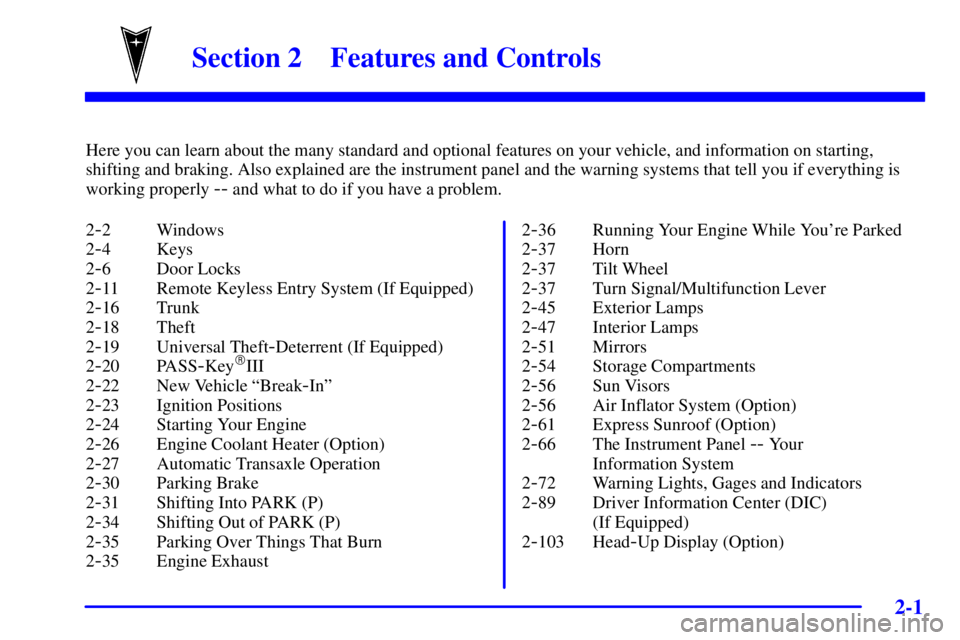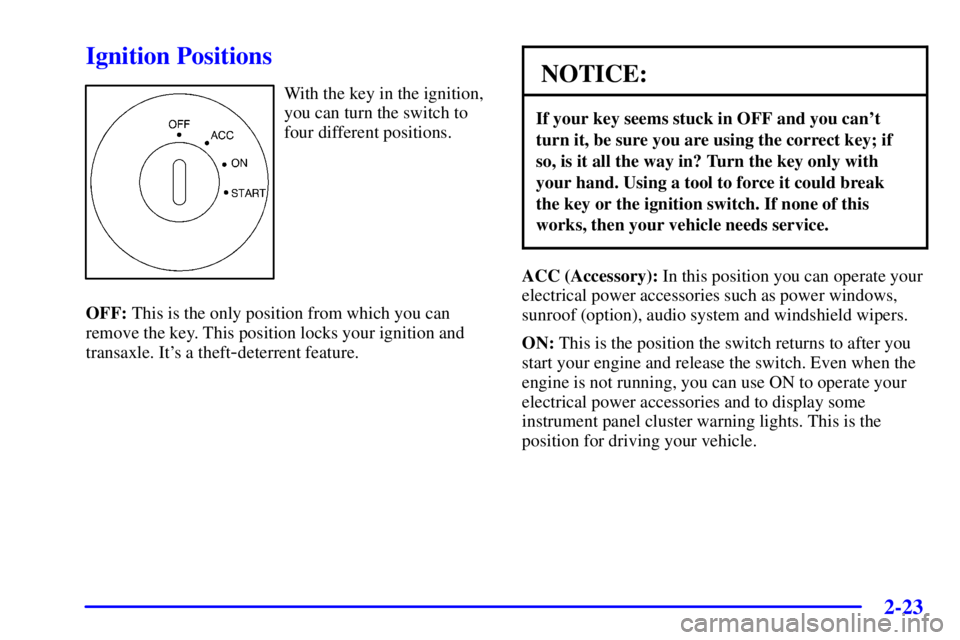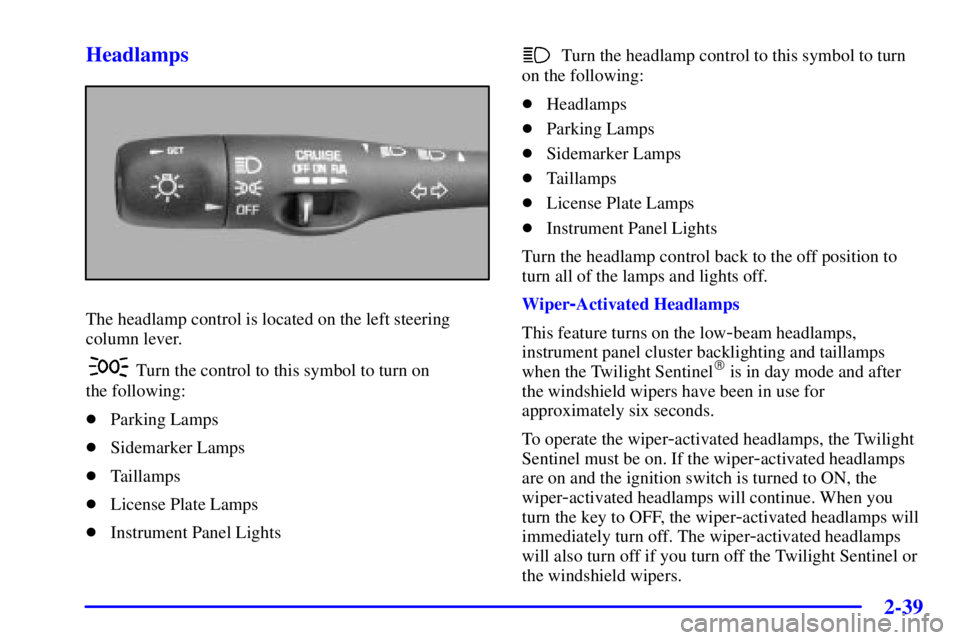Page 4 of 413
Table of Contents
Windows
Keys and Door Locks
Remote Keyless Entry System (If Equipped)
Trunk Release
Automatic Transaxle
Parking Brake
Tilt Wheel
Turn Signal/Multifunction Lever
Windshield Wipers
Cruise Control
Exterior and Interior LampsMirrors
Storage Compartments
Convenience Net (Option)
Accessory Power Outlet
OnStar® System (If Equipped)
Sunroof (Option)
HomeLink® Transmitter (If Equipped)
Instrument Panel, Warning Lights and Gages
Driver Information Center (Option)
Memory and Personalization
Head-Up Display (Option) Seats and Seat Controls
Safety BeltsAir Bag Systems
Restraint Systems for Children
Section
1
Section
2
Seats and Restraint Systems
Features and Controls
ii
Page 11 of 413

ix
For example,
these symbols
are used on an
original battery:
CAUTION
POSSIBLE
INJURY
PROTECT
EYES BY
SHIELDING
CAUSTIC
BATTERY
ACID COULD
CAUSE
BURNS
AVOID
SPARKS OR
FLAMES
SPARK OR
FLAME
COULD
EXPLODE
BATTERY
These symbols
are important for
you and your
passengers
whenever your
vehicle is driven:
CHILD
RESTRAINT
TOP STRAP
ANCHOR
DOOR LOCK
UNLOCK
FASTEN
SEAT
BELTS
POWER
WINDOW
AIR BAG
These symbols
have to do with
your lamps:
MASTER
LIGHTING
SWITCH
TURN
SIGNALS
PARKING
LAMPS
HAZARD
WARNING
FLASHER
DAYTIME
RUNNING
LAMPS
FOG LAMPS
These symbols
are on some of
your controls:
WINDSHIELD
WIPER
WINDSHIELD
WASHER
WINDSHIELD
DEFROSTER
REAR
WINDOW
DEFOGGER
VENTILATING
FAN
These symbols
are used on
warning and
indicator lights:
ENGINE
COOLANT
TEMP
BATTERY
CHARGING
SYSTEM
BRAKE
COOLANT
ENGINE OIL
PRESSURE
ANTI-LOCK
BRAKES
Here are some
other symbols
you may see:
FUSE
LIGHTER
HORN
FUEL
Vehicle Symbols
These are some of the symbols you may find on your vehicle. Also see ªWarning Lights and Gagesº in the Index.
Page 68 of 413

2-
2-1
Section 2 Features and Controls
Here you can learn about the many standard and optional features on your vehicle, and information on starting,
shifting and braking. Also explained are the instrument panel and the warning systems that tell you if everything is
working properly
-- and what to do if you have a problem.
2
-2 Windows
2
-4 Keys
2
-6 Door Locks
2
-11 Remote Keyless Entry System (If Equipped)
2
-16 Trunk
2
-18 Theft
2
-19 Universal Theft-Deterrent (If Equipped)
2
-20 PASS-Key�III
2
-22 New Vehicle ªBreak-Inº
2
-23 Ignition Positions
2
-24 Starting Your Engine
2
-26 Engine Coolant Heater (Option)
2
-27 Automatic Transaxle Operation
2
-30 Parking Brake
2
-31 Shifting Into PARK (P)
2
-34 Shifting Out of PARK (P)
2
-35 Parking Over Things That Burn
2
-35 Engine Exhaust2
-36 Running Your Engine While You're Parked
2
-37 Horn
2
-37 Tilt Wheel
2
-37 Turn Signal/Multifunction Lever
2
-45 Exterior Lamps
2
-47 Interior Lamps
2
-51 Mirrors
2
-54 Storage Compartments
2
-56 Sun Visors
2
-56 Air Inflator System (Option)
2
-61 Express Sunroof (Option)
2
-66 The Instrument Panel -- Your
Information System
2
-72 Warning Lights, Gages and Indicators
2
-89 Driver Information Center (DIC)
(If Equipped)
2
-103 Head-Up Display (Option)
Page 90 of 413

2-23
Ignition Positions
With the key in the ignition,
you can turn the switch to
four different positions.
OFF: This is the only position from which you can
remove the key. This position locks your ignition and
transaxle. It's a theft
-deterrent feature.
NOTICE:
If your key seems stuck in OFF and you can't
turn it, be sure you are using the correct key; if
so, is it all the way in? Turn the key only with
your hand. Using a tool to force it could break
the key or the ignition switch. If none of this
works, then your vehicle needs service.
ACC (Accessory): In this position you can operate your
electrical power accessories such as power windows,
sunroof (option), audio system and windshield wipers.
ON: This is the position the switch returns to after you
start your engine and release the switch. Even when the
engine is not running, you can use ON to operate your
electrical power accessories and to display some
instrument panel cluster warning lights. This is the
position for driving your vehicle.
Page 106 of 413

2-39 Headlamps
The headlamp control is located on the left steering
column lever.
Turn the control to this symbol to turn on
the following:
�Parking Lamps
�Sidemarker Lamps
�Taillamps
�License Plate Lamps
�Instrument Panel Lights
Turn the headlamp control to this symbol to turn
on the following:
�Headlamps
�Parking Lamps
�Sidemarker Lamps
�Taillamps
�License Plate Lamps
�Instrument Panel Lights
Turn the headlamp control back to the off position to
turn all of the lamps and lights off.
Wiper
-Activated Headlamps
This feature turns on the low
-beam headlamps,
instrument panel cluster backlighting and taillamps
when the Twilight Sentinel
� is in day mode and after
the windshield wipers have been in use for
approximately six seconds.
To operate the wiper
-activated headlamps, the Twilight
Sentinel must be on. If the wiper
-activated headlamps
are on and the ignition switch is turned to ON, the
wiper
-activated headlamps will continue. When you
turn the key to OFF, the wiper
-activated headlamps will
immediately turn off. The wiper
-activated headlamps
will also turn off if you turn off the Twilight Sentinel or
the windshield wipers.
Page 112 of 413

2-45
Exterior Lamps
Headlamps
See ªTurn Signal/Multifunction Leverº in the Index.
Daytime Running Lamps
Daytime Running Lamps (DRL) can make it easier for
others to see the front of your vehicle during the day.
DRL can be helpful in many different driving
conditions, but they can be especially helpful in the
short periods after dawn and before sunset. Fully
functional daytime running lights are required on all
vehicles first sold in Canada.
A light sensor on top of the instrument panel monitors
the exterior light level for the operation of DRL and
Twilight Sentinel
�, so be sure it isn't covered.
The DRL system will make your high
-beam headlamps
come on at a reduced brightness when the following
conditions are met:
�The ignition is on,
�the headlamp control is off, and
�the transaxle is not in PARK (P).When the DRL are on, only your high
-beam headlamps
will be on at reduced intensity. The taillamps,
sidemarker and other lamps won't be on. Your
instrument panel won't be lit either.
When it's dark enough outside, your regular intensity
headlamps will come on at full brightness and the DRL
lighting will turn off. The parking lamps that normally
come on with your headlamps will also come on. When
it's bright enough outside, the regular intensity
headlamps and parking lamps will turn back off, and the
reduced brightness DRL lighting will turn back on.
To idle your vehicle during the day with the DRL off,
shift the transaxle into PARK (P). The DRL will stay off
until you shift out of PARK (P).
At night, you can turn off all exterior lamps when you
are in PARK (P) by turning the Twilight Sentinel knob
all the way to OFF.
If the knob was already in OFF, it must be cycled to
ON and back to OFF. Turn the knob clockwise to turn
the exterior lighting back on. The lamps will come back
on automatically when you put the transaxle in gear.
As with any vehicle, you should turn on the regular
headlamp system when you need it.
Page 114 of 413

2-47
If the Twilight Sentinel lighting is active, it can be
disabled by turning on the manual parking lamps.
This lighting will be disabled until the key is turned
from ON or until the manual parking lamps are
turned off.
Also, it's possible that your headlamps may go out if
you drive from a dark area into a bright area like a
lighted parking lot. If this happens, turn on your
headlamps with the regular headlamp control.
Exterior Lighting Battery Saver
If the manual lamp control has been left on, the exterior
lamps will turn off approximately 10 minutes after the
ignition is turned to OFF and any door has been opened.
This protects against draining the battery in case you
have accidentally left the headlamps or parking lamps
on. If you need to leave the lamps on for more than
10 minutes, use the manual control to turn the lamps
back on after turning the ignition to OFF and opening
any door. To delay the lamps from turning off, see
ªTwilight Sentinel
�º in the Index.
Interior Lamps
Instrument Panel/Brightness Control
When it is dark outside, you can brighten or dim your
instrument panel cluster lights by turning the DIM knob
in the light control. Turn the knob clockwise to brighten
the instrument panel cluster lights and displays. Turn the
knob clockwise all the way to turn on the interior
courtesy lamps. Turn the knob counterclockwise to dim
the instrument panel cluster lights and displays and to
turn off the courtesy lamps.
Courtesy Lamps
If it is dark enough outside, when any door is opened,
several lamps will come on. They make it easier for you
to enter and leave the vehicle. Turn the dimmer knob all
the way clockwise to turn the interior courtesy lamps on.
Page 135 of 413
2-68
Instrument Panel Clusters
The instrument panel clusters are designed to let you know at a glance how your vehicle is running. You'll know how
fast you're going, how much fuel you're using, and many other things you'll need to drive safely and economically.
Your vehicle is equipped with one of these instrument panel clusters, which includes indicator warning lights and
gages that are explained on the following pages.
Standard Cluster (United States version shown, Canada similar)